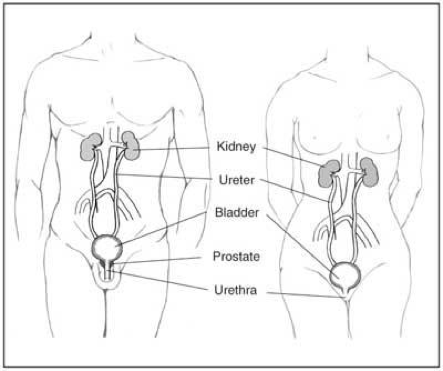The Bladder

Reprinted with permission from the National Institute of Diabetes and Digestive and Kidney Diseases, National Institutes of Health.
The bladder is a hollow organ in the lower abdomen. It stores urine, the waste that is produced when the kidneys filter the blood. The bladder has an elastic and muscular wall that allows it to get larger and smaller as urine is stored or emptied.
Urine passes from the two kidneys into the bladder through tubes called ureters. Urine leaves the bladder through another tube called the urethra.
About Cancer
The body is made up of many types of cells. Normally, cells grow and divide to produce more cells only when the body needs them. Sometimes cells keep dividing when new cells are not needed. These cells form a mass of extra tissue called a growth or tumor. Tumors can be benign or malignant.
Benign tumors are not cancer. They often can be removed and, in most cases, they do not come back.
Malignant tumors are cancer. Cells in malignant tumors are abnormal and divide without control or order.
Bladder Cancer
There are three types of bladder cancer:
- Transitional cell: About 90 percent of bladder cancers are transitional cell carcinomas. These are cancers that begin in the cells lining the bladder. Cancer that is only found in the lining of the bladder is superficial bladder cancer.
- Squamous cell: Cancer that begins in squamous cells. Squamous cells are thin, flat cells that may form in the bladder.
- Adenocarcinoma: Cancer that develops in the inner lining of the bladder.
Treatment
Some treatments are standard – the currently used treatment – and some are being tested in clinical trials. Before starting treatment, patients may want to think about taking part in a clinical trial.
A clinical trial is a research study meant to help improve current treatments or obtain information on new treatments. When clinical trials show that a new treatment is better than the standard treatment, the new treatment may become the standard treatment. Ask your doctor if a clinical trial is available for your type of cancer.
Four Types of Standard Treatment
There are four types of standard treatment including surgery, radiation, chemotherapy and immunotherapy.
The type of surgery chosen depends on the type of bladder cancer. Superficial cancer may be treated by removing only the tumor. If surgery to remove the bladder is your best treatment option, your doctor will discuss the procedure with you. In some cases, patients receive chemotherapy after surgery to kill any cancer cells that are left. Treatment given after surgery, to increase the chances of a cure, is called adjuvant therapy.
Radiation treatment uses high-energy X-rays or other types of radiation to kill cancer cells or keep them from growing. There are two types of radiation. External radiation therapy uses a machine outside the body to send radiation toward the cancer. Internal radiation therapy uses a radioactive substance that is placed directly into or near the cancer. The type of the radiation given depends on the type and stage of the cancer.
Chemotherapy is a cancer treatment that uses drugs to stop the growth of cancer cells. It kills the cancer cells or stops them from growing. Chemotherapy is often used to treat bladder cancer that has spread to other parts of the body (called metastasis) such as the lymph nodes.
Immunotherapy (sometimes called biologic therapy) is a treatment that uses the patient’s immune system to fight cancer. Substances made by the body or made in a laboratory are used to boost, direct or restore the body’s natural defenses against cancer.
